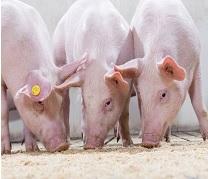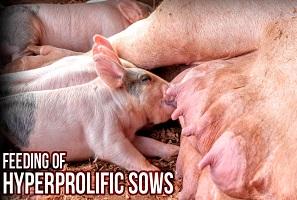Maternal supplementation with natural antioxidants (Herbal C and Herbal E) during pregnancy in sows
Published: January 13, 2023
By: Indian Herbs/ Contact: Dr. Shivi Maini
Background Information
Major changes in the swine industry during the last quarter century have significantly influenced vitamin nutrition of swine. Improvements in the efficiency of swine production system through selection has necessitated a reappraisal of dietary requirements of vitamins.

Antioxidant Vitamin Supplementation options for pigs
Bioavailability of some vitamins in various feedstuffs is another much debatable issue. Premix abuse can contribute to borderline vitamin deficiencies attributed mainly to interference with the stability of vitamins. Some vitamins are much less stable than others viz. vitamin C and E. Indian Herbs Specialities Ltd, India took the initiative to develop natural and stable range of vitamins for optimum swine production.
Herbal C
Herbal C (M/S Indian Herbs Specialties, India) is a unique herbal animal feed supplement that contains selected herbs rich in small hydrolysable gallo-tannoids and bio-flavonoids in conjugated form, having Vitamin C activity. Whereas synthetic Vitamin C is highly unstable and gets quickly excreted from the physiological system, Herbal C is stable, gets fully absorbed and provides self replicating and sustained activity. The retention and activity of synthetic Vitamin C is reduced by 10% every month during storage at room temperature and by more than 80% during palletization, Herbal C remains stable during storage at room temperature and even at high temperature pelletization also. Herbal C exerts nearly 6 times more potent antioxidant action as compared to synthetic coated Vitamin C. Unlike synthetic Vitamin C which can not be added to swine feed due to very poor stability and retentivity and high cost, it has now become possible to meet nutritional requirement of Vitamin C with availability of Herbal C which is natural, highly stable, bioavailable, bioactive and cost-effective natural Vitamin C. Herbal C is recommended to be supplemented to young piglets during first two weeks of life when they donot have any ability to synthesize vitamin C. Herbal C in young piglets helps to maintain optimum physiological functions and for building immuno-competence. Herbal C is supplemented alongwith swine ration for prevention of oxidative stress, tropocollagen synthesis, osteoblast formation, matrix mineralization and bone resorption in pigs.
Herbal E
Supplementing Synthetic vitamin E to pig ration is also associated with several disadvantages. Synthetic Vitamin E (dl-a-tocopherol) is unstable and highly susceptible to oxidation. When synthetic vitamin E (dl-a-tocopheryl acetate) is added to pig ration, the acetate groups start splitting due to alkalinity of feed, as feed contains limestone and/or magnesium oxide (a common base material for vitamin premix), and the released free tocopherol is easily oxidized. However, the natural composition of Herbal E (M/S Indian Herbs Sepcialites, India) remains highly stable in acidic as well as alkaline pH. Herbal E is a unique herbal product that contains Vitamin E and equivalents in natural and highly bio-available form. Natural forms of Vitamin E are known to get quickly absorbed, slowly excreted and are more bio-active as compared to synthetic Vitamin E i.e. dl--tocopherol. Herbal E contains a unique combination of α, and forms of natural Vitamin E that are synthesized by plants. Supplementing Herbal E to pigs is recommended for preventing the oxidation of unsaturated fatty acids, for important neutrophil functions, phagocytosis, optimizing immune-status and as a co-therapy in management of MMA syndrome.
Oxidative Stress and IUGR in gestating sows
Improvement of prolificacy has been mainly achieved by the selection of genotypes with a high ovulatory rate and consequently a high number of developing fetuses. However, the space into the uterus for the adequate development of the fetuses and their placentae is limited, so large litters are affected by deficiencies of placental development affecting the functionality of the organ and, therefore, the supply of oxygen and nutrients to the fetuses. The consequence is the impairment of fetal growth in a process known as intrauterine growth restriction (IUGR), leading to low birth-weight (LBW) neonates. The reduced supply of nutrients and oxygen to the IUGR fetuses causes malnutrition and hypoxia which, in turn, increases their oxidative stress. Hence, a possible strategy for counteracting IUGR may be based on the administration of antioxidant agents which ameliorate the antioxidant/oxidative status, improve the placental function, and increase the birth weight and viability of the offspring. Specifically, previous studies in sheep with twin pregnancies have shown that maternal oral supplementation with antioxidant vitamins C and E during pregnancy increases these vitamins in the cord blood of near-to-term fetuses, diminishing their oxidative stress and increasing their body weight.
Maternal supplementation of vitamin C leads to increase in its concentrations in the fetus increases during late gestation, but serum and liver ascorbic acid concentration declines in the sow, presumptively by an increased transfer of vitamin C to the fetus and to the mammary gland. The low plasma concentrations of vitamin C in the sow and the high concentration of the vitamin in offspring have been explained by a large maternal–fetal transfer through the placenta, which is retained by the fetus. Placental vitamin C transport maintains higher vitamin C concentration on the fetal side of the placenta than on the maternal side and such transport is mediated at the placenta by a specific transporter termed Sodium-dependent Vitamin C Transporter2 (SVCT2). Afterwards, there is also a large amount of vitamin C transferred from maternal plasma to colostrum in the case of the newborn. In fact, vitamin C in sow colostrum reaches more than 30 mg/dL, which is about 50-fold higher than in maternal plasma.
Previous studies under experimental conditions have shown that such combination improves the antioxidant/oxidative status of the sow and favors the transfer of vitamin E to the piglets and their postnatal growth patterns. These results suggest that supplementation with antioxidant agents is a promising strategy for diminishing incidence and consequences of IUGR in swine.
Research Study validates efficacy of supplementing Herbal antioxidants to improve reproductive efficiency in sows, litter traits and piglet performance
Combination of two herbal antioxidants natural vitamin C & E (Herbal C and Herbal E) were evaluated for its efficacy during pregnancy on reproductive traits and piglet performance (number of live, dead, and mummified newborns and litter weight at birth and individual body weight at both birth and weaning) in a total of 1027 sows (504 treated and 523 control females) kept under commercial breeding conditions at commercial farm in Chile (Agrosuper, Rancagua, Chile) under standard commercial swine breeding conditions (. Parraguez et al.,2022).

The supplementation increased the number of live-born piglets (13.64 ± 0.11 vs. 12.96 ± 0.13 in the controls; p = 0.001) and the total litter weight, decreasing the incidence of low-weight piglets without affecting the number of stillbirths and mummified newborns. Such an effect was modulated by the number of parity and the supplementation, with supplementation increasing significantly the number of living newborns in the first, second, sixth, and seventh parities (0.87, 1.10, 1.49, and 2.51 additional piglets, respectively; p < 0.05). The evaluation of plasma vitamin concentration and biomarkers of oxidative stress (total antioxidant capacity, TAC, and malondialdehyde concentration, MDA) performed in a subset of farrowing sows and their lighter and heavier piglets showed that plasma levels of both vitamins were significantly higher in the piglets than in their mothers (p < 0.05 for vitamin C and p < 0.005 for vitamin E), with antioxidant supplementation increasing significantly such concentrations. Supplementation of herbal antioxidants decreased plasma MDA levels both in the sows and their piglets (p < 0.05). Finally, the piglets from supplemented mothers showed a trend for a higher weaning weight (p = 0.066) and, specifically, piglets with birth weights above 1 kg showed a 7.4% higher weaning weight (p = 0.024).
Results of present trial revelaed that supplementing herbal antioxidants to pregnant sows had an attenuating effect on maternal oxidative stress, as indicated by the significant reduction in plasma MDA concentration and increasing TAC. Such improvement in oxidative status was related to the high concentration of antioxidant vitamins reached by the piglets. The results of present study suggest that supplementation with herbal antioxidants is proven to be a very promising strategy for improving health status and development of newborns. Importantly, the assessment of productive traits showed that the supplementation of sows during pregnancy increases the number of live-born piglets and the total litter weight, decreasing the incidence of low-weight piglets, without affecting the number of stillbirths and mummified newborns. Herbal antioxidants supplementation is proven to be highly efficacious in mitigation of extreme level of oxidative stress occurring in sows during late gestation and in piglets around farrowing. Hence, the results of the present study, with high robustness and translational value by offering data from more than 1000 pregnancies under standard breeding conditions, supports that maternal supplementation with herbal antioxidants during pregnancy significantly improves reproductive efficiency, litter traits, and piglet performance.
Conclusion
Antioixdant vitamin supplementation is a prerequisite for profitable and sustainable pig farming. Anitoixdant vitamin C is essential in many metabolic processes, including vitamin E recycling, collagen biosynthesis and an important role in the functionality of the immune system. Most production species are able to endogenously synthesize sufficient vitamin C specially in the young age (piglets). The usual vitamin C and vitamin E supplements are very unstable to heat, humidity and light. Herbal C is a mixture of plants components containing highly stable and bioactive vitamin C analogues, that guarantee up to 6 times more antioxidant capacity than the normally used sources of Vitamin C. Herbal E contains a unique combination of α, and forms of natural Vitamin E that are synthesized by plants. Both natural antioxidant vitamins are highly heat stable with high antioxidant sustained bioactivity. Supplementing sows throughout gestation with herbal antioxidants significantly improves reproductive efficiency, litter characteristics, and piglet performance during the birth-weaning period.
Related topics:
Authors:
Indian Herbs
Recommend
Comment
Share

Would you like to discuss another topic? Create a new post to engage with experts in the community.







